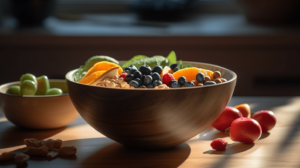Are you looking to improve your digestion and lose weight? Well, look no further! Fiber is here to save the day.
You may not realize it, but fiber is the unsung hero for digestion and weight loss. It is crucial in keeping your digestive system running smoothly and can even help you shed those extra pounds.
When it comes to digestion, fiber is like a superhero. It helps to keep things moving along in your digestive tract, preventing constipation and promoting regular bowel movements.
Not only that, but fiber also acts as a prebiotic, nourishing the good bacteria in your gut. This helps to maintain a healthy balance of bacteria and can improve overall gut health. So, let’s explore the different types of fiber, how much you should be consuming, and some tips for easily incorporating fiber-rich foods into your daily routine.
Key Takeaways
- Fruits and vegetables are a great source of fiber.
- Colorful fruits and vegetables should be included in daily diet.
- Whole grains and legumes are high in fiber and should be consumed.
- Swapping refined grains for whole grain alternatives is beneficial for increasing fiber intake.
The Role of Fiber in Digestive Health
Fiber is a type of carbohydrate that your body’s enzymes can’t break down, so it travels through your digestive system intact. This may seem insignificant, but it actually has a profound impact on your overall digestive health.
Consuming foods rich in fiber, such as fruits, vegetables, and whole grains, adds bulk to your stool and helps regulate your bowel movements. This means that fiber helps prevent constipation and keeps your digestive system running smoothly.
In addition, fiber acts as a prebiotic, nourishing the beneficial bacteria in your gut. These bacteria play a vital role in digestion, helping to break down food, absorb nutrients, and fight off harmful bacteria. By promoting the growth of these good bacteria, fiber helps maintain a healthy balance in your gut and supports optimal digestion.
But fiber doesn’t just benefit your digestive health, it also plays a key role in weight loss. High-fiber foods are typically low in calories and take longer to chew, which can help you feel full and satisfied with less food.
Additionally, fiber slows down the emptying of your stomach, which means you’ll feel fuller for longer after a meal. This can help prevent overeating and make sticking to a healthy diet easier.
How Fiber Aids in Weight Loss
Imagine yourself effortlessly shedding those extra pounds as your body becomes a lean, fat-burning machine with the help of this powerful dietary component. Fiber is not only essential for digestive health, but it also plays a crucial role in weight loss. When it comes to shedding those stubborn pounds, fiber can be your secret weapon.
Fiber aids in weight loss in several ways. First, it adds bulk to your meals, making you feel fuller for longer. You’re less likely to overeat or snack on unhealthy foods throughout the day. Additionally, fiber slows down digestion, which helps regulate blood sugar levels and prevents sudden spikes and crashes that can lead to cravings and overeating.
To help you visualize the impact of fiber on weight loss, let’s take a look at the following table:
| High-Fiber Meal | Low-Fiber Meal | |
|---|---|---|
| 1 | A generous serving of fresh vegetables | A small portion of processed carbohydrates |
| 2 | Lean protein (such as grilled chicken) | Fatty meat (such as fried chicken) |
| 3 | Whole grains (such as quinoa or brown rice) | Refined grains (such as white bread) |
| 4 | A variety of colorful fruits | Sugary desserts or snacks |
| 5 | Plenty of water | Sugary beverages |
As you can see, the high-fiber meal is filled with nutrient-dense foods that provide satiety and nourishment, while the low-fiber meal is packed with empty calories and processed ingredients. By choosing high-fiber options, you can fuel your body with the nutrients it needs and avoid the pitfalls of unhealthy eating habits.
Types of Fiber and Their Benefits
You may not realize it, but there are actually different types of fiber that can provide various benefits for your body. Fiber is not a one-size-fits-all nutrient.
Here are four types of fiber and their incredible benefits:
- Soluble Fiber: This type of fiber dissolves in water and forms a gel-like substance in your digestive system. It helps to slow down digestion and keeps you feeling full for longer. Soluble fiber can also help lower cholesterol levels by binding to bile acids in the intestine and preventing their reabsorption into the bloodstream.
- Insoluble Fiber: Unlike soluble fiber, insoluble fiber does not dissolve in water. Instead, it adds bulk to your stool and helps promote regular bowel movements. Insoluble fiber is a natural laxative, preventing constipation and keeping your digestive system healthy.
- Resistant Starch: This type of fiber is resistant to digestion in the small intestine and instead reaches the large intestine intact. Resistant starch acts as a prebiotic, providing food for the beneficial bacteria in your gut. This can help improve gut health and boost the immune system.
- Functional Fiber: Functional fiber is a type of fiber that is added to foods or supplements. It’s often derived from natural sources such as fruits, vegetables, or grains. Functional fiber can help regulate blood sugar levels, improve heart health, and promote satiety.
Recommended Daily Fiber Intake
Getting enough fiber every day is crucial for maintaining a healthy digestive system and promoting weight management. Fiber is the unsung hero that keeps everything running smoothly in your body. It not only helps to regulate bowel movements and prevent constipation, but it also aids in weight loss by keeping you feeling full and satisfied for longer periods of time. So, how much fiber should you be getting each day?
The recommended daily fiber intake varies depending on your age and gender. According to the Academy of Nutrition and Dietetics, adult men under 50 should aim for 38 grams of fiber per day, while adult women in the same age group should aim for 25 grams. For adults over the age of 50, the recommended daily fiber intake decreases slightly to 30 grams for men and 21 grams for women. However, these are just general guidelines and individual needs may vary.
To help you get a better understanding of how much fiber is in common foods, here is a table showcasing some examples of fiber-rich foods and their fiber content per serving:
| Food | Fiber Content (per serving) |
|---|---|
| Apples | 4.4 grams |
| Black beans | 15 grams |
| Whole wheat bread | 3 grams |
| Broccoli | 5.1 grams |
| Lentils | 15.6 grams |
| Almonds | 3.5 grams |
How Does Fiber Impact the Microbiome and Weight Management?
Fiber plays a crucial role in microbiome and weight management. It promotes the growth of beneficial bacteria in the gut, leading to better digestion and metabolism. Additionally, fiber helps to regulate appetite and contributes to a feeling of fullness, which can aid in weight management.
Tips for Incorporating More Fiber into Your Diet
One easy way to increase your fiber intake is by adding more fruits and vegetables to your meals. Not only are they delicious and nutritious, but they also contain a good amount of fiber. Try incorporating a variety of colorful fruits and vegetables into your diet each day.
For example, have a bowl of mixed berries for breakfast, a salad with lots of leafy greens for lunch, and a side of steamed broccoli or roasted sweet potatoes with dinner. By doing so, you’ll not only be increasing your fiber intake, but also getting a wide range of vitamins, minerals, and antioxidants that are beneficial for your overall health.
In addition to fruits and vegetables, whole grains are another great source of fiber. Swap out refined grains like white bread and pasta for whole grain alternatives such as whole wheat bread, brown rice, and quinoa. You can also incorporate more legumes into your meals, such as beans, lentils, and chickpeas. These are not only high in fiber but also provide a good amount of plant-based protein.
Get creative with your meals and try new recipes with fiber-rich ingredients. Remember, every small step you take towards increasing your fiber intake is a step towards better digestion and weight loss.
Frequently Asked Questions
What are some common sources of fiber in the diet?
Some common sources of fiber in your diet include fruits like apples and berries, vegetables like broccoli and carrots, whole grains like oats and brown rice, and legumes like beans and lentils.
Can increasing fiber intake help with constipation?
Increasing your fiber intake can definitely help with constipation. While you may initially experience some bloating or gas, the long-term benefits of regular bowel movements and improved digestion make it worth it.
How does fiber improve gut health?
Fiber improves gut health by promoting regular bowel movements, preventing constipation, and reducing the risk of digestive disorders like diverticulosis. It also feeds beneficial gut bacteria, which aids in nutrient absorption and supports overall digestive function.
Can fiber supplements be used as a substitute for dietary fiber?
Fiber supplements can be a convenient option, but they shouldn’t be seen as a substitute for dietary fiber. Whole foods provide a variety of nutrients and benefits that supplements can’t replicate.
Does cooking or processing food affect its fiber content?
Yes, cooking and processing food can affect its fiber content. Heat and processing methods can break down or destroy some of the fiber, so it’s best to consume fruits and vegetables in their raw or lightly cooked form.














